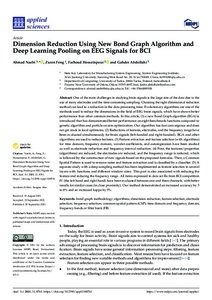Dimension Reduction Using New Bond Graph Algorithm and Deep Learning Pooling on EEG Signals for BCI
Hosseinpour Farhoud; Naebi Ahmad; Feng Zuren; Abdollahi Gahder
Dimension Reduction Using New Bond Graph Algorithm and Deep Learning Pooling on EEG Signals for BCI
Hosseinpour Farhoud
Naebi Ahmad
Feng Zuren
Abdollahi Gahder
MDPI
Julkaisun pysyvä osoite on:
https://urn.fi/URN:NBN:fi-fe2021120158455
https://urn.fi/URN:NBN:fi-fe2021120158455
Tiivistelmä
One of the main challenges in studying brain signals is the large size of the data due to the use of many electrodes and the time-consuming sampling. Choosing the right dimensional reduction method can lead to a reduction in the data processing time. Evolutionary algorithms are one of the methods used to reduce the dimensions in the field of EEG brain signals, which have shown better performance than other common methods. In this article, (1) a new Bond Graph algorithm (BGA) is introduced that has demonstrated better performance on eight benchmark functions compared to genetic algorithm and particle swarm optimization. Our algorithm has fast convergence and does not get stuck in local optimums. (2) Reductions of features, electrodes, and the frequency range have been evaluated simultaneously for brain signals (left-handed and right-handed). BGA and other algorithms are used to reduce features. (3) Feature extraction and feature selection (with algorithms) for time domain, frequency domain, wavelet coefficients, and autoregression have been studied as well as electrode reduction and frequency interval reduction. (4) First, the features/properties (algorithms) are reduced, the electrodes are reduced, and the frequency range is reduced, which is followed by the construction of new signals based on the proposed formulas. Then, a Common Spatial Pattern is used to remove noise and feature extraction and is classified by a classifier. (5) A separate study with a deep sampling method has been implemented as feature selection in several layers with functions and different window sizes. This part is also associated with reducing the feature and reducing the frequency range. All items expressed in data set IIa from BCI competition IV (the left hand and right hand) have been evaluated between one and three channels, with better results for similar cases (in close proximity). Our method demonstrated an increased accuracy by 5 to 8% and an increased kappa by 5%.
Kokoelmat
- Rinnakkaistallenteet [19207]
